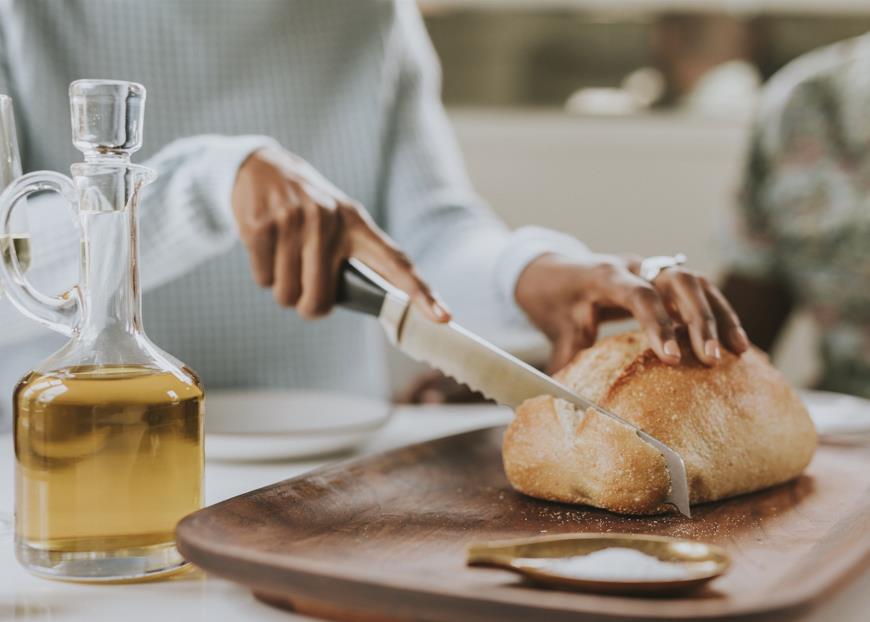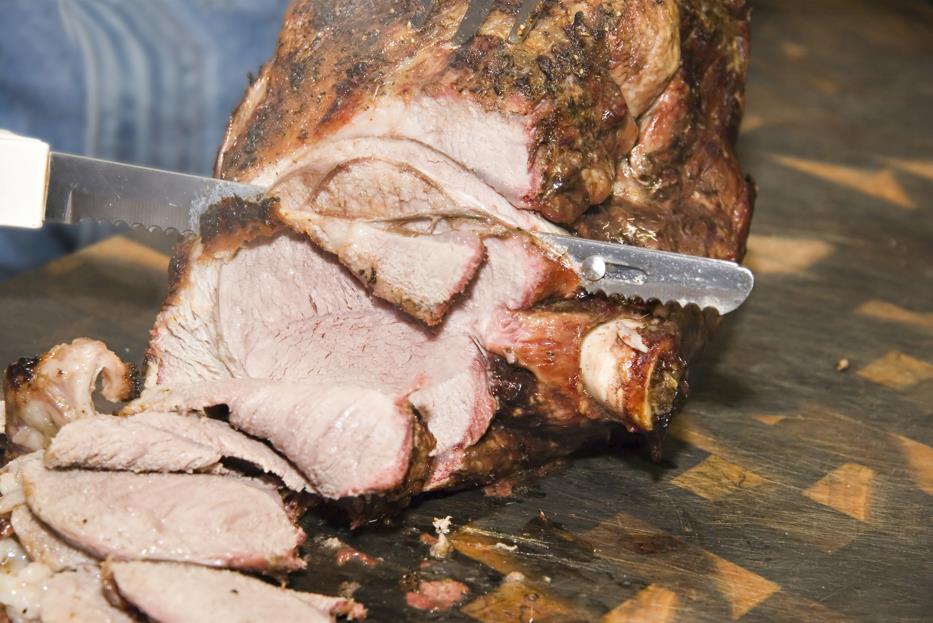The serrated edge is the most distinctive feature of a bread knife. This trait makes bread knives such versatile tools that every cook should possess, whether beginner or professional.
Undoubtedly, a bread knife won’t have struggles cutting through all kinds of bread without messing up the crust or breaking apart the soft inside. After all, it’s the intended purpose of a bread knife, but there is more to them than meets the eye. You can consider them multi-purpose knives to cut through many things other than bread effortlessly.
In this article, we’ll show you ways to think outside of the box and where to utilize bread knives in the kitchen.
Table of contents
What exactly is a bread knife?
A bread knife is a special kind of knife designed to cut through bread. The flat or curved edge (plain) of a chef’s knife cuts by slicing, which requires pressing on the ingredients. This can result in the bread’s crust breaking apart and not getting smoothly cut pieces of bread in the end.
That’s where the serrated edge helps. You can cut through bread in more like a sawing motion rather than pressing that won’t damage it. This also means there won’ be pressure on the bread, and each slice will look a lot fuller and fluffier.
Surely, a very sharp chef’s knife can cut bread as good as a dedicated bread knife, but that extra use can dull the edge of your primary knife faster, and you’ll need to sharpen and hone more often.
With bread knives, aside from having a dedicated tool to cut bread easily, you’ll also preserve the life of kitchen knives that you otherwise would use to cut other things.
The serrated edge
Bread knives have a toothed/saw-like edge that best cuts ingredients in a back and forth movement. In comparison to a kitchen knife with a plain edge, serrated edges are used for sawing through foods rather than slicing.
This type of blade edge comes in handy when cutting things that are soft, flexible, and crush easily with downward pressure. That’s pretty much how loaves of bread are, but they aren’t the only thing a serrated edge is best used. Here are the best uses of a bread knife’s serrated blade.
Cut bread

As it’s a bread knives’ purpose, you can cut all kinds of loaves without crushing the crust and soft inside. Although a bread knife will help you cut bread easily, it can result in an unwanted outcome where the bread falls apart into pieces if you don’t know how to use a bread knife properly.
How to use a bread knife
The following is a short tutorial on using a bread knife to cut bread.
- Hold the blade against the bread at a curved angle with the tip facing down. This will help you go back and forth effortlessly without damaging the crust.
- Slightly press on the bread and move the blade back and forth.
- As you get close to the bottom, place the tip of the knife on the cutting board. Doing this won’t damage the cutting board as bread knives function as mini saws that can make significant marks.
- Optionally, you can lift the bread slightly on one side to slice the bottom.
Other than bread, take advantage of the serrated bread knives to cut different ingredients. Here are other types of foods where you can utilize bread knives, to name a few.
Cut pastries and cakes
There are many upsides to cutting cakes and pastries with a bread knife. Cakes and pastries are a lot similar to bread without the hard crust on the outside. Using a long serrated blade means slicing an entire cake layer in a single cut. This creates even pieces that look symmetrical and pleasing to the eye.
Additionally, you can use the serrated edge to prepare ingredients for your cakes, like chocolate. Because chocolate is extremely hard, the pressure of a chef’s knife may crack, the serrated edge will be worth your while when preparing your own chocolate chips.
Cut fruits and vegetables
One of the benefits of the serrated edge is that it creates smooth cuts with anything hard on the outside but soft on the inside. This sounds like many fruits and vegetables.
You can also cut through soft fruits and veggies without creating a mess on your cutting board with a bread knife, as the juices won’t spill as much compared to cutting with a paring knife.
Additionally, the saw-like edge makes it a perfect tool to cut through fruits with thick skins like watermelons. Using a serrated knife is also safer when cutting fruits like this. With a plain-edged knife, you may not be able to move through the blade to the point where it gets stuck to the fruit, requiring you to use force.
Since a situation like this can be dangerous, utilizing a bread knife to cut melons will be safer and easier. The blade won’t get stuck on the rind, and even if it does, using a little bit of force to move it back and forth will help cut through the melon as if it was a smaller fruit.
Furthermore, the serrated edge can be helpful when cutting certain ingredients like tomatoes. The tomato skin is soft yet challenging to cut, and most cooks have a challenge with cutting unless their knives are razor-sharp.
A serrated blade that a bread knife has is a safer and more efficient way to cut tomatoes for most people, especially when following recipes that require a lot of them.
Our favorite all-purpose knives
True cutting power in the palm of your hand
Can you cut meat with a bread knife?

While the serrated edge can be superior to a plain edge in specific situations, they are certainly not for meats. Cutting meat or chicken breasts with a bread knife will almost always result in uneven cuts and dull the blade a lot faster.
However, there are serrated steak knives that are designed for meat cutting. What makes them different from bread knives is that the series of sharp teeth are much closer and smaller.
These types of serrated knives with sharp pointy tips are acceptable for cutting cooked meat but not for cutting a chunk of meat to cook later. Instead, use a sharp chef’s knife, utility knife, or a cleaver to cut meats.
Should you get a bread knife?
With all the use cases of a bread knife, you might wonder whether or not to get one. If baked goods are a staple in your diet, investing in a high-quality bread knife will give you an easier time, not just to slice them but also in other tasks where a serrated blade comes in handy.
How to sharpen a bread knife?
Cutting ingredients with a bread knife is pretty straightforward, but sharpening isn’t as much. Luckily, serrated knives aren’t exactly the types of knives that dull quickly. Nevertheless, you will need to sharpen your bread knife every now and then to get the best performance.
The tricky part about sharpening a bread knife is that you will need to sharpen each serration individually. Due to this, a whetstone isn’t the best tool to sharpen a bread knife. Instead, use a honing rod, preferably a ceramic one. Here is how to sharpen a serrated bread knife.
- Place the tip of the honing rod on a stable surface like your countertop.
- Have a feel for the angle of the serration on the blade with your finger.
- Put the edge against the rod at the right angle and start honing each tooth a few times.
- After the entire blade is finished, hone the blade like you would do with a chef’s knife to remove the burr.
As honing gets your knives sharper but doesn’t create a new edge, you might need to take your bread knife to a professional sharpener if it struggles to cut. Regular use of a honing rod to realign the sharp edge is the best way to have a sharp bread knife that cuts effortlessly.
How to clean and store a bread knife?
The general cleaning and storage methods to any other kitchen knife apply to bread knives. This includes cleaning by hand and drying it after use.
However, one crucial thing to keep in mind when storing serrated knives is not to let the edge touch other utensils. As it’s incredibly challenging to sharpen a serrated knife, you will want to keep it away from other knives.
It’s also bad for the blades that a bread knife gets in contact with as it can chip the edges and damage them, especially if it’s a ceramic knife. Learn more about proper knife storage methods.
How to choose the right bread knife?
The idea of a perfect bread knife varies. Every cook is different and so are their needs. If you don’t know what’s on your mind, here are a few things to consider when shopping for a brand new bread knife.
Length
The length of a bread knife can be anywhere from 7 to 12 inches. 9 inches is the optimum length for most people, but if you’re cutting lots of bread and cakes, a longer blade might be better suited for you.
Sharpening
Because it takes more time and effort to sharpen a serrated blade, take a look at how often you’re going to use it. Using a blade more often than not will make it dull faster. If you plan on frequently using a bread knife, go with one made from high carbon steel. However, high-carbon steel requires more maintenance than others due to oxidation. If you’re not so keen on cleaning and drying your knife every time you use it, a high carbon stainless steel bread knife would be a better pick.
Price
A more expensive bread knife won’t necessarily mean a better one. When shopping for kitchen knives, the price should be at the back of your mind, but it definitely shouldn’t be the determining factor.
Most bread knives are between $20 and $40, with professionally designed ones costing upwards of $50. Take a look at the materials used to make the bread knife and the overall quality to see if it’s worth the money.
With all the use cases of a bread knife, it’s worth having one in the kitchen. They are extremely easy and fun to use on ingredients that you can cut with a serrated edge.
If you’re looking for different types of cutlery to add to your arsenal of kitchen knives, take a look at our collection.












